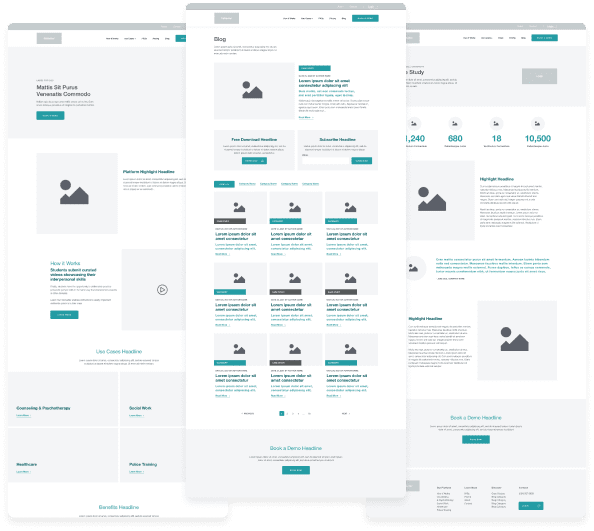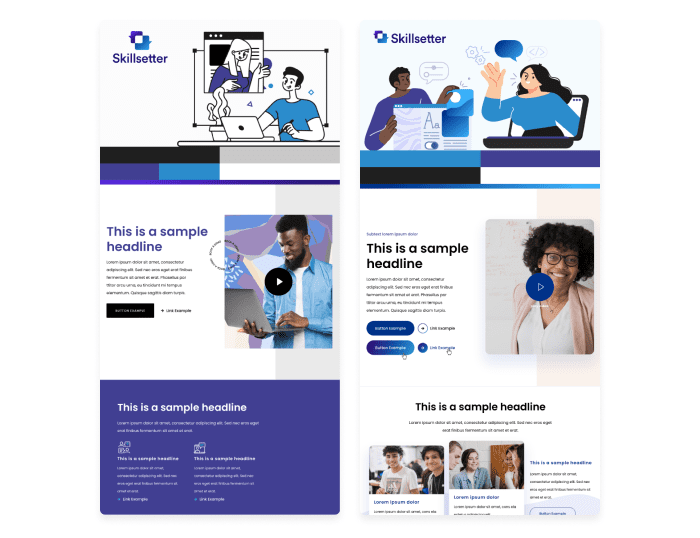We LOVE analogies at Forge and Smith, and our favourite one is how the website redesign process is just like renovating your home.
Think about it: your website is the home from your brand, and for your valuable content.
Potential customers arrive on a first visit hoping to get to know you better, and to decide if they like you enough to make it official. They look around, check out your vibe, and explore your stuff to see if you’re a match. They’ve been to other houses and know what they like in a house – they won’t think twice about making a hasty exit if yours is disappointing.
- You need to make a great first impression for new visitors so they come back
- You need to keep it tidy and functional for the people who live there (your own team)
- You also can’t take loyal friends (repeat customers) for granted by letting it get run down or messy
Making your website a desirable destination means knowing who you are as a business and exactly what people need from you, then building your home to seamlessly fulfill those needs.
Ready to go all-in on this home-building analogy?
The Forge and Smith crew are your architects, builders, decorators, and party planners, and our finely honed web design process is how we build your content’s dream home. Hard hat and steel-toed boots required beyond this point!
Post Contents
- The Website Redesign Process
- 1. Kickoff Research: Planning
- 2. Information Architecture: MOAR Planning
- 3. UX Design: Blueprinting
- 4. Content Gathering: Shopping & Packing
- 5. Style Tiles: Planning Interior Décor
- 6. Web Design: Decorating
- 7. Web Development: Building
- 8. Population & Migration: Moving!
- 9. QA, SEO & Training: Handoff
- 10. Hosting & Maintenance
- 11. Digital Marketing: Make them Come to You!
The Website Redesign Process
1. Kickoff Research: Planning
It goes without saying that you don’t just knock down your walls without a plan. How strategic you are, and the time you spend preparing, speak to how much you care about the outcome.
Our process kicks off with a meeting with several of our strategists to recap goals, and ask existential questions like why your business exists, what you offer, and who this website is for. There’s a big difference between a bachelor suite and a house for a growing family with lots of hobbies.
We take notes, then launch an SEO audit of your site and your competitors’ sites, and a content audit of your site.
If you don’t have brand guidelines to drive the project, we can also guide you through that process. It’s super important that we’re all on the same page about who you are and what you do before we touch the construction materials!
Read more: How to Develop a Brand Strategy.
2. Information Architecture: MOAR Planning
We’re a strategic agency, so you’d better believe there’s planning at every stage of a website redesign.
At this stage we understand who you are, who’s coming over, and what you hope will happen when they visit. It’s time to strategize exactly how to get them to take the ideal actions in your house – convert.
We review your content audit with you, then craft a preliminary sitemap, followed by a full sitemap. This is the easiest way to get your brain warmed up to plan what needs to go in your new house, and how people will move through it for a satisfying experience.

The sitemap is like an early blueprint. It documents:
- The number of pages on the site
- How the pages are connected in a hierarchical order
- How visitors will quickly find the most important content
- How visitors can discover similar content
Read more: Information Architecture: Why It Matters for Your Website.
3. UX Design: Blueprinting
Now we all have a good idea of your content, and we’re going to get super-serious about mapping it to the new space.
Time to meet the architect: a user experience (UX) designer. They take the sitemap and build it out into wireframes, which are a working prototype of every single page and menu in your site.


Much like a structural blueprint, the prototype doesn’t contain any colour. That’s because we need your focus on how the house works, not how it looks. That comes later! Right now, you get to take a virtual walk through the house assessing:
- That it has the right number of doors and windows (menus and buttons)
- That the halls and stairs go to the right rooms (lateral navigation) and the rooms are on the right floors and in optimal locations (user experience)
- That the renovation can hold all of your appliances (content blocks)
- That we didn’t forget space for any of the content you and your guests need (pages and posts)
As in construction, you don’t want to realize you missed something major after the foundation is poured. That will usually mean extra costs, which nobody wants.
Read more: UX Design 101: What Makes a Great Website?
4. Content Gathering: Shopping & Packing
Although shopping and packing are fun for certain personality types (like me!), most people find this stage pretty taxing.
Your renovated house plan is not the same as the layout of your existing house, which means you can’t expect everything to match up without effort. You might have dramatically expanded your services or products, gone through a rebrand, or decided to deepen your content for improved conversions and SEO.
And because the sitemap and prototype introduce your actual belongings into the renovation, they almost always reveal rooms that you don’t have enough content to fill, or areas where your content is too outdated to fit with the improved room. Yup, lots do here.
In our process, we give you a custom WordPress content prototype that’s built from your approved UX designs. It’s a simple, blocks-based system to collect all of the content needed for the new website. We also provide support for sourcing images, copy editing, copywriting, and SEO advice because we’re awesome like that.
Read more: How to Write Tasty Website Content.
5. Style Tiles: Planning Interior Décor
At the same time as you’re gathering content, you get to experience everybody’s favourite stage of all: actual web design.
We use your brand guidelines, the kickoff research, and a separate brand kickoff meeting to explore how you want people to feel in your home, what impression they should take away, and your business personality. All of this is used to create style tiles.
These are like mood boards. They mock up samples of colour palettes, typography, imagery, and CTA buttons – much like a collage an interior designer would present.


It’s all about look and feel, tone and direction; possibilities, not limitations! We aren’t putting paint on the walls (because there aren’t yet any walls).
Read more: Style Tiles: A Design Teaser.
6. Web Design: Decorating
Here’s where the analogy takes a little side-step. In a home renovation, you wouldn’t start decorating before you build.
But the way a website redesign works is the pages get designed, then the files are handed to web developers to build. All things aesthetic are decided by you and the designers by mocking up every single room of your house in full, glorious colour, and then the construction crew does all of your interior decorating for you.
Here’s how it works:
- Your style tiles are applied to the UX design of your homepage, usually with placeholder stock images and ‘lorem ipsum’ Latin copy – this is so you can focus on the look and feel without getting hung up on the content, which you’re still busy gathering
- When that’s approved, we design all of the other pages for your review
- Now you can finally see how your new home will look!
Read more: UX vs. UI: How they Work Together in Web Design.
7. Web Development: Building
Construction begins. Your approved designs are translated into website code to create a custom WordPress home for your brand and your content.
Our developers are like framers, finishing carpenters, glaziers, plumbers, electricians, painters, and interior decorators all in one.
I’ll be honest, I have no idea how a developer writes all that code, but I saw the movie Hackers and assume it’s just like that.


Read more: Why You Should Choose WordPress for Business Websites.
8. Population & Migration: Moving!
The great thing about moving day in cyberspace is that no one will see your furniture sprawled out on the curb while you wait for the moving truck, and you don’t have to carry any couches up flights of stairs. Migrating content to your new site is invisible to the public eye.
Plus, our team does the moving and unpacking for you.
This means populating the new site with everything you gathered in the content prototype, and any direct migrations we can do such as exporting a WordPress blog and importing it to the new site.
We don’t have a blog post about content migration, but I highly recommend this article about how to prepare for a website redesign!
9. QA, SEO & Training: Handoff
There’s a flurry of activity that leads up to launch day, aka THE day when our crew of websmiths finishes building your content’s new home and you get it all to yourself.
At Forge and Smith, this includes:
- A rigorous QA process that starts with internal QA by our team, then full rounds of QA by your team to make sure everything looks and performs correctly on all devices
- Pre- and post-launch SEO to ensure the site launches smoothly, any errors are quickly caught and dealt with, and you’re set up tracking data with Google Analytics, Google Tag Manager, and Google Search Console
- WordPress training on how to manage content using your new site
You give us the word, and your new home is officially available to the world.
Read more: The Top 12 Website KPIs for Small Business.
10. Hosting & Maintenance
We don’t just hand over the keys and wave goodbye. We’re here to make sure it lives up to expectations!
For example, houses don’t keep themselves in mint condition. Every home requires routine maintenance on its structure and appliances, or little upgrades. That’s why we offer web hosting and maintenance packages. We can be the tradespeople who come around fixing things and keeping your home functioning the way it should.
Read more: Our web hosting and maintenance services.
11. Digital Marketing: Make them Come to You!
That whole “if you build it, they will come” thing does NOT apply to websites. Google doesn’t have to rank or even recognize your website, if you don’t give it reason to do so. That’s where digital marketing comes into play.
If you want the right sort of people to be able to find your house on the map, and to come by and make friends with you and expand your network of valuable relationships… you need to invest in a marketing strategy.
What that looks like will be unique to your business. It should always include SEO and content marketing. Maybe it will also involve social media, email, influencer marketing, PPC, or PR. Who knows! Just kidding – we know because we did so much research into your business.
Part of ensuring that your content’s new home is a success is helping get people to visit said home, enjoy the experience, and tell others. That’s why we incorporate SEO into every single stage of our website redesign process, and offer retainer services (if you like our faces and want to spend more time with us!).
Read more: Our digital marketing services.
Our website redesign process isn’t the same as what you would do with another agency.
We think ours is the best out there, because we believe that a smooth, repeatable process is the key to success. You can always adjust your process for unique needs, but having no process, or a messy one, is always going to create headaches for everyone involved.
Do your research (check out our tips on what to consider when hiring a web design agency), ask about their process, and pick a partner that’s the best fit for your business.





